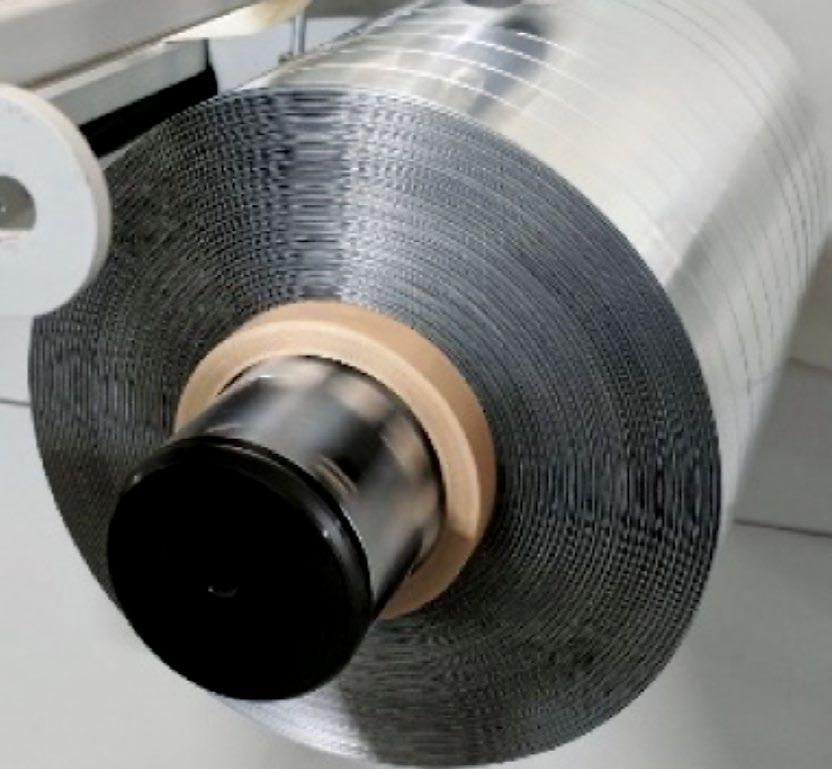








A manufacturer of high-speed, high-bandwidth Category 6A data communications cables has upgraded its product quality while reducing the need for material splice changeovers during production runs with engineering assistance from Web Industries, Inc.’s Industrial business.
The assistance comes in the form of custom-designed laminated discontinuous aluminum shielding tape and 16-inch wide spools capable of unwinding 25,000 linear ft. of the cable maker’s specified laminated tape structure.
The business now enjoys longer uninterrupted production runs with the longest spooled shielding tape available in the datacom industry and the virtual elimination of product rejects due to shielding foil breaks, ragged edges, delamination, and tensile weakness.
The upgrade had humble beginnings with Web Industries’ Business Development Manager Charlie Belcher conducting a routine overview designed to inform the cable producer’s management that Web engineered and manufactured much more than just the fire-retardant cable fillers it had been providing for the past several years.
Belcher explained that Web’s Industrial business offers a sweeping range of specialized products and services to datacom, telecom, and power/energy and control cable manufacturers. These include precision-tuned signal isolation tapes, binder and identification tapes, metal armoring tapes, and innovative specialty laminates for custom-tailored cable solutions.
Perhaps more important was Web’s extraordinary capacity for product development, backed by the company’s engineering ingenuity and depth of experience. “I explained that Web was open to just about any cable component-related challenge our customer might encounter,” Belcher says. “And that prompted some deep thinking among the executive engineers and senior product development folks in the room.”
It was not long before Belcher fielded a query about Web’s potential to produce a better shielding tape than the one currently protecting the company’s 6A datacom cables.
The tape in question was a discontinuous film/foil shield. That is, the tape’s aluminum foil component is discontinuous, leaving slight gaps when the tape is wrapped around the cable core during assembly. The design makes grounding wires and shielded connectors unnecessary while effectively protecting the cable’s core of twisted wire pairs from electromagnetic interference (EMI) and alien crosstalk (ANEXT). This lowers total installation time and expense compared with conventional shielding tapes that have continuous aluminum shielding and must be grounded on both ends to prevent overload during power surges.
The discontinuous shielding tape’s concept was excellent, but the current supplier’s production was inconsistent and at times faulty.
• Shielding tape linear ft. throughput up by 325%
• Reliable, high-performance discontinuous aluminum shielding tape.
• Higher quality shielding tape is free of rough edges and nicks.
• Greater cable manufacturing throughput.
“Previously, the datacom cable manufacturer would find instances where a part of the shielding tape’s aluminum foil that was supposed to be completely segmented was actually still connected,” Belcher says. “And this fault could not be detected until the finished cable underwent electrical testing. In practice, this meant that the manufacturer would complete every process of cable production, from wrapping the shielding tape around the cable’s core to extruding a rubber or pvc jacket over the assembly. If electrical testing showed that the shielding tape was not discontinuous and failed, then they would lose the entire cable due to that one defect.”
Other quality concerns had to do with delamination and rough edges. If lamination is not done properly, there is potential for the substrate to come apart or delaminate, which is not the case with the “destructive bond” that Web’s laminating platform produces.
The product’s slitting also caused problems with nicks undermining the tape’s tensile strength and rough edges having the potential to catch on forming dies during processing. All told, the datacom cable manufacturer had ample reason to consider alternative sourcing.
Belcher returned to Web Industries’ Hartford, Conn. plant with shielding tape specs in hand for their engineering department to evaluate. Although Web was not producing discontinuous aluminum shielding at the time, its manufacture proved well within the company’s core competence. In fact, Web would soon turn out a much smoother-edged, nick-free, precision laminated shielding tape, plus a spooling advantage that would save the datacom cable maker production time. More on spooling in a moment.
Web formatted its first test run of shielding tape by meeting the cable manufacturer’s specs right down to the film’s 1 in. width and 7,700 linear ft. length in slit pads. The tape underwent in-house tensile, lamination bond strength, slit edge and segment cut quality testing, and then quickly passed customer approvals. “This was yet another example of Web solving a customer’s product performance challenge while adding to its portfolio of custom-tailored material and component solutions,” Belcher says.
Web then put its engineering ingenuity to further work. It recommended, trialed, and had approved the supply of shielding tape in lengths of 11,000 linear ft., an increase of 43% over the previously supplied 7,700 linear ft. length. The longer length rolls enabled the cable producer to increase production by reducing the number of shielding tape splices required.
Upon the cable maker’s total satisfaction with the longer 11,000 ft. length, Web Industries proposed an even longer length, one of 25,000 linear ft., an additional 127%. The greatly increased length would be supplied in a parallel wind pattern on Web’s new 16-inch wide, traverse wound spools, the largest in the datacom industry. The changeover would call for the datacom cable manufacturer to modify its unwinds and invest in an accumulator that eliminated the need to ramp-up and ramp-down line speed to splice the tape during cable production.
The investment yielded deep dividends. Ultimately, the cable company lowered the number of splices needed when processing from 3.2 per 7,700 linear ft. split rolls to just one for the 25,000 linear ft. on 16-inch wide spools, a 325% increase in shielding tape throughput.
Web Industries’ new high-capacity 16-inch wide spools can accommodate up to 75 lbs. of material. Conventional spools are 12-inches wide. The wider spools produce an immediate boost in throughput compared with slit pads and 12-inch wide spools. For example: A production line that converts from a 12-inch spool to a 16-inch spool increases its throughput on average by 200% or more depending on the manufacturer’s outer diameter limitations.
Because the larger spools require fewer changeovers and less operator intervention, the chances for human error are reduced, which opens the door for resource sharing, where operators can be reassigned or are able to support other productive activities.
Web Industries custom-designs large traverse wound spools to customer specifications. The company uses proprietary technology and purpose-built equipment to design spools with highly precise wind patterns, including those with a specific percentage of overlapping winds. Web engineers work closely with prospective customers to phase in and test large-format traverse wound spools on their cable manufacturing lines.

Web now supplies its datacom cable customer with over 50 million linear ft. of high performance discontinuous shielding tape per year.
The world’s top wire & cable manufacturers trust our innovative engineering, converting, and manufacturing solutions to improve their products and their bottom lines. Contact Web Industries at sales@webindustries.com to find out why.
The cable producer and Web Industries are currently evaluating additional applications where Web’s engineering expertise and depth of material formatting knowledge can further streamline the current cable manufacturing process and support development of next-generation cable designs. www.webindustries.com